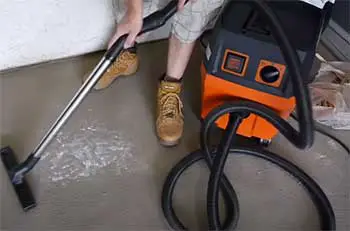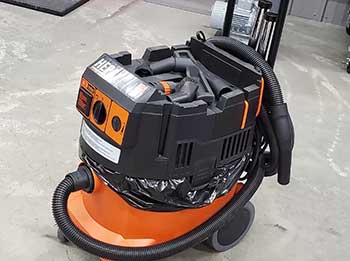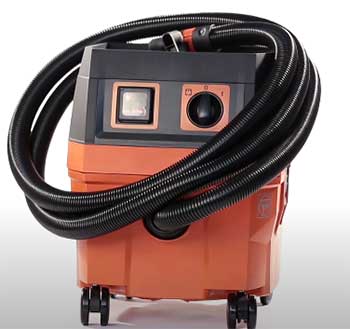If you’re in the market for a powerful yet quiet dust extractor, the Fein Turbo series should definitely be on your radar.
As leading dust extractors made by German power tool specialists Fein, the Turbo 1 and Turbo 2 offer sturdy build quality and great suction power for everything from home DIY jobs to professional contracting work.
But with two models available, how do you know which one is right for you? In this detailed comparison, we’ll examine the key features and performance of the Fein Turbo 1 and Turbo 2 to help you decide.
A Brief Comparison Table
| Feature | Turbo 1 | Turbo 2 |
| Suction Power | 210 air watts | 235 air watts |
| Dust Class | L-class (≥ 1 micron) | L-class (≥ 1 micron) |
| Filter Type | Fleece | PET folded |
| Noise Level | 76 dB | 72 dB |
| Size | 585 x 365 x 345mm | 540 x 380 x 340mm |
| Rear Wheels | 280mm | 350mm |
| Weight | 9kg | 10.5kg |
| Dust Container Volume | 17 liters | 20 liters |
| Warranty | 2 years domestic, 1 year professional | 2 years domestic, 1 year professional |
Key Takeaways
- The Turbo 2 has 10% more suction power and a longer lasting filter.
- It operates at a lower noise level of 72 dB vs 76 dB on the Turbo 1.
- The Turbo 2 is more maneuverable with lower body height and bigger wheels.
- It also offers a 17% larger 20 liter dust container.
- The Turbo 1 remains a great affordable option, but the Turbo 2 is better for professional use.
Overview And Differences of The Fein Turbo 1 And 2

The Fein Turbo 1 was released in 2010 as a compact yet powerful dust extractor ideal for home DIY and renovations.
With its iconic green color, rugged plastic body and large rear wheels, it’s built for mobility around worksites.
In 2016, Fein introduced the next generation Turbo 2 model.
This upgraded version has a more maneuverable body shape, higher suction power and longer filter life. However, the Turbo 1 remains available at a lower price point.
Both models have an automatic filter cleaning system, HEPA filters, and power tool activation. They extract dry dust safely and efficiently for applications like sanding, drilling, cutting and chiseling. Let’s look at how they compare in more detail:
Suction Power
- Turbo 1: 210 air watts max suction
- Turbo 2: 235 air watts max suction
The Turbo 2 has around 10% more suction power from its upgraded 1400W motor (vs 1200W on the Turbo 1). This gives better dust collection efficiency when paired with power tools.
Real world tests show the Turbo 2 outperforms the Turbo 1 when used for sanding, especially with fine dust. So if you’ll be doing lots of high-suction tasks, the extra power of the Turbo 2 is beneficial. But for more casual DIY use, the Turbo 1 has ample suction.
Dust Class and Filter Type
- Turbo 1: L-class (≥ 1 micron), fleece filter
- Turbo 2: L-class (≥ 1 micron), PET folded filter
Both models filter down to the finest L-class dust, capturing dangerous fine particles as small as 1 micron. This includes dust from activities like concrete drilling, brickwork and sanding which can cause respiratory irritation.
However the Turbo 2 uses a more advanced PET folded filter which lasts up to 50% longer than the fleece filter in the Turbo 1. If you’ll use the extractor frequently, the Turbo 2’s improved filter will save you time and money on replacements.
Noise Levels
- Turbo 1: 76 dB
- Turbo 2: 72 dB
The Turbo 2 runs quieter than the Turbo 1 thanks to improved sound insulation. At just 72 dB on its highest suction setting, it’s able to hold a conversation over without shouting. This makes it better suited to noise-sensitive areas like homes and offices if you’ll be doing indoor jobs.
Size and Maneuverability
- Turbo 1:
- Height: 585mm
- Width: 365mm
- Depth: 345mm
- Rear wheels: 280mm
- Weight: 9kg
- Turbo 2:
- Height: 540mm
- Width: 380mm
- Depth: 340mm
- Rear wheels: 350mm
- Weight: 10.5kg

With its updated body styling, the Turbo 2 has a slightly lower and longer footprint compared to the upright Turbo 1.
It sits lower to the ground for easier lifting and access to the filter, and has larger rear wheels that roll smoothly over terrain.
Combined with the rear pivoting castors, the Turbo 2 is more maneuverable around tight spaces and jobsites.
The Turbo 1 is a bit lighter at 9kg, while the Turbo 2 weighs 10.5kg due to its larger motor and wheels. But both models have integrated handles and are reasonably portable for their powerful suction capabilities.
Dust Container Volume
- Turbo 1: 17 liters
- Turbo 2: 20 liters
The Turbo 2 has a 17% larger dust collection tank over the Turbo 1. At 20 liters total volume, you’ll need to empty it less frequently during big jobs. The plastic tanks are durable and transparent so you can monitor fill levels.
Features and Attachments
Both the Turbo 1 and Turbo 2 come with a standard assortment of attachments:
- Hard floor tool
- Crevice nozzle
- Upholstery tool
- Filter cleaning fleece
- Suction hose
- Power tool connector
The main difference is the Turbo 2’s upgraded floor tool with swivel joint for better maneuverability. It also includes a holder for the crevice nozzle.
In terms of features, both have automatic filter cleaning, power tool activation via a connected switch, and overload protection. The Turbo 2 adds extra functionality like its longer-life filter, electric suction power regulation, and fine dust display that tells you when to clean the filter.
So if you want the latest attachments and features, the Turbo 2 is the more advanced model. But the Turbo 1 comes well-equipped for most cleaning duties.
Warranty
Fein covers both models with a 2 year warranty for domestic use, and 1 year for professional use. This covers defects in materials and workmanship. Wear parts like filters and nozzles are excluded beyond 90 days.
Prices
As you’d expect, the flagship Turbo 2 costs more than the older Turbo 1 model:
- Turbo 1: Around $400 online
- Turbo 2: Around $500 online
However the prices fluctuate at retailers so keep an eye out for any sales or deals. And prices may vary outside the US.
For the improved suction, longer filter life, lower noise and updated design, the Turbo 2 represents good value if it fits your budget. But the Turbo 1 remains a high performing extractor at a more affordable price point.
Turbo 1 Or Turbo 2: Which One To Pick?
Based on this comparison, here are some final recommendations on choosing between the two Fein Turbo models:

- For professional all-day use or fine dust collection, the Turbo 2 is worth the upgrade for its higher suction power, longer-lasting filter and low noise.
- For home DIY use or as a “starter” extractor, the Turbo 1 still performs excellently despite lacking the latest upgrades.
- On a tight budget, opt for a refurbished or used Turbo 1 to get Fein quality for less.
- If noise is a major concern due to children, pets or neighbors, the quieter Turbo 2 is the better pick.
- For large projects with lots of debris, get the Turbo 2 for its larger 20L dust tank.
- If you’ll use your extractor with multiple power tools, go for the Turbo 2 to take advantage of its higher suction capabilities.
So in summary, while the Turbo 2 is the newer and more advanced model, the original Turbo 1 remains a great “bang for your buck” option. Think about your needs and budget to decide which one suits you best!
Frequently Asked Questions (FAQ)
The main differences are:
1. The Turbo 2 has higher suction power (235 air watts vs 210 on the Turbo 1).
2. It has a longer lasting PET folded filter instead of the fleece filter on the Turbo 1.
3. It operates at a lower noise level of 72 dB compared to 76 dB on the Turbo 1.
4. The Turbo 2 is more maneuverable with a lower body height and bigger wheels.
5. It offers a 20 liter dust container vs 17 liters on the Turbo 1.
The Turbo 1 runs at 76 dB on its highest suction setting. Meanwhile the Turbo 2 operates more quietly at 72 dB thanks to improved sound insulation. This makes the Turbo 2 better for noise-sensitive indoor areas.
The “L-class” rating refers to the dust particle sizes that an extractor can filter down to. L-class means the extractor can capture particles as small as 1 micron for the finest dust. Both the Turbo 1 and Turbo 2 achieve this L-class filtration, making them suitable for fine dust applications like sanding and drilling which produce dangerous small dust.
Closing Remarks
For serious DIYers or professionals, the Turbo 2 is worth the upgrade with its higher suction and durability. But the Turbo 1 still performs impressively for more casual home use, despite lacking the latest features.
Evaluate your needs and budget to decide between these two excellent Fein dust extractors.
